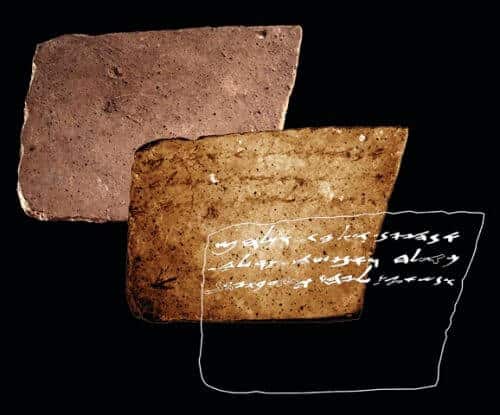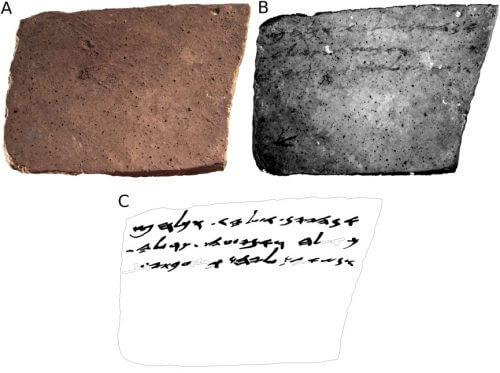The pottery shard, which was excavated in the 60s and is currently on display in the Israel Museum, was considered for decades to have a letter on one side. The discovered address deals with the delivery of wine and food supplies to a military unit in Tel Arad

An interdisciplinary team of researchers from Tel Aviv University was able to read a Hebrew ink inscription from the days of the Kingdom of Judah on a pottery shard (ostracon), which was excavated in the 60s in Tel Arad and was considered for decades to be a clean letter.
The special interdisciplinary research was conducted by the doctoral students Shira Feigenbaum-Golovin, Aryeh Schaus and Barak Sober from the Department of Applied Mathematics and Dr. Anat Mandel-Gabrovich from the Department of Archaeology, under the guidance of Prof. Eli Pisetsky from the School of Physics and Astronomy and Prof. Israel Finkelstein from the Department of Archeology at Tel Aviv University. Michael Kordonsky and Prof. Murray Moinster from the Department of Physics, Prof. Eli Turkel and Prof. David Levin from the Department of Applied Mathematics, and Prof. Benjamin Zass from the Department of Archeology also participated in the research.
The article was published On Wednesday (14.6.17) in the journal PLoS ONE.
"The level of literacy at the end of the First Temple was very high, but the significant texts of the period were written on papyri - which did not survive the humidity of the Land of Israel," says doctoral student Shira Feigenbaum-Golovin. "The few Hebrew inscriptions that have survived from the days of the Bible, a few hundred in total, are everyday inscriptions in ink, written on pottery shards."
In the early 60s, the late archaeologist Yohanan Aharoni, former head of the archeology department at Tel Aviv University, uncovered 91 such pottery fragments in the Tel Arad citadel - the largest corpus of Hebrew inscriptions from the time of the First Temple.
"Betel Arad was a military fortress on the southern border of the Kingdom of Judah," explains Dr. Mendel-Gabrovich. "It is a fort with an area of about two dunams, in which about 20 to 30 soldiers served. The inscriptions date to a short period in the last phase of the fort's history, on the eve of the destruction of the kingdom by Nebuchadnezzar in 586 BC. Some of the Arad inscriptions are addressed to a man named Elyashiv ben Ushihu, who was apparently the apsanai of the citadel. These are logistical correspondences that talk mainly about the supply of flour, wine and oil to army units that operated in the area."

"All the Arad inscriptions have been thoroughly studied since the 60s and some of them are regularly displayed in the Israel Museum," says doctoral student Barak Sober. "We have developed a new multispectral photography method, which divides the visible wavelengths into finer and more precise segments, and adds wavelengths outside the visible range, such as infrared light. We wanted to recheck the faded inscriptions and make sure the human eye didn't miss anything. We thought we had a nice method in hand, but it turns out that we were looking for Athens and found a kingdom: a completely new inscription, which sat for fifty years in a museum and none of the experts saw that it was there."
Using the photography method they developed, the researchers were able to read additional letters and words in the inscription on one side of the same pottery - and three "new" lines on the other side, which is considered empty. These lines deal with the delivery of supplies to a military unit.
"We believe that the letter we uncovered on side B is a direct continuation of what is written on side A," explains doctoral student Aryeh Shaus. "This is a request letter for the issuance of wine and food from the warehouses of the Arad fortress to one of the military units. The addressee of the letter is Eliashiv, the same logistics officer of the Arad Citadel who stars in these addresses, while the addressee, Hananiyahu, lives elsewhere, possibly in Beer Sheva. In addition, a messenger named Galihu is also mentioned here, who was sent to Arad with a shipment of wine."
"The importance is not in the text itself, which is an administrative text," says Dr. Mendel-Gabrovich. "The importance is that we have very few texts from the days of the First Temple, and every additional sign provides us with a whole world. In these three lines and on the front side of the inscription, we identified new words that are unknown to research and do not appear in the Bible, words that have just been added to the Hebrew dictionary.
Now, the researchers intend to photograph using the method that they developed for all Hebrew inscriptions from the days of the First Temple. "We want to make sure that the human eye hasn't missed any additional addresses," says Schaus. "I believe that in the future multispectral photography will be an integral part of every new excavation. It hurts my heart to think about inscriptions that may have been thrown in the trash simply because they could not be distinguished in the field."

3 תגובות
UNESCO in response - there is no connection between the Hebrew inscription and the Jews. Only Islam has…
Can't believe how this organization has become political and lacks credibility.
very disturbing How do you publish an article with an immediate translation of the text into English and not bother to publish it in Hebrew, with the letters copied into the square script we use today? In addition to this, the absence of new and unfamiliar words, and their possible meaning from the context, is striking.
What is not an ancient Palestinian inscription about the delivery of hummus?